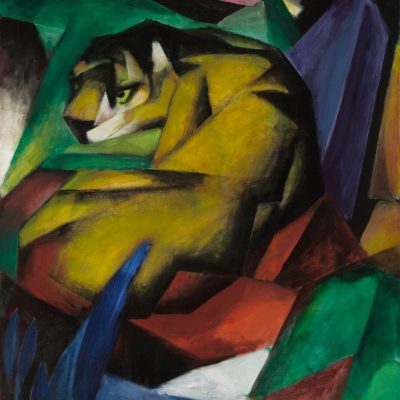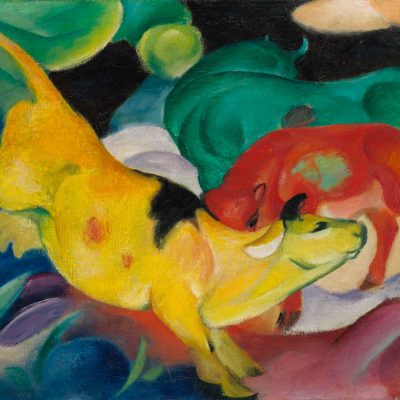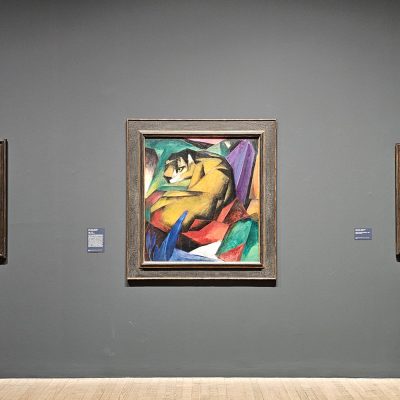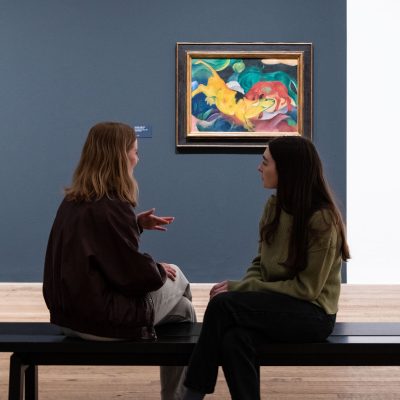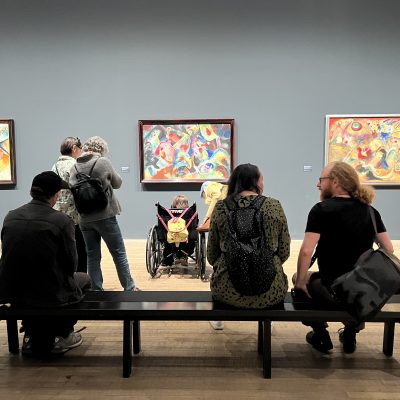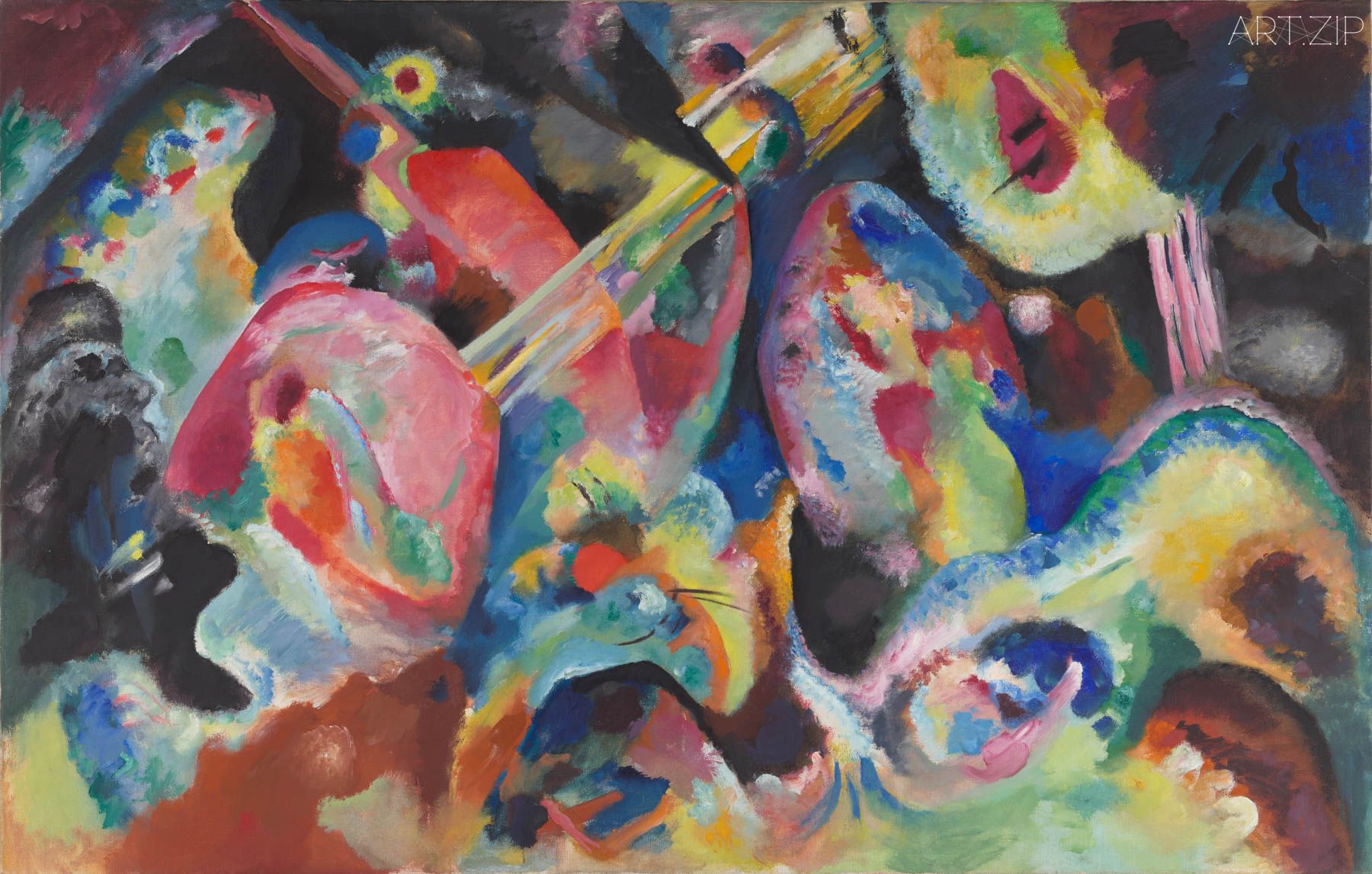
A gallery is designed to pass through as if it might stand in for the imaginary staging of historical passage. They are invariably crowded places, so passage is often interrupted or straited rather than smooth and continuous. If it is sculpture, there is a circulation around it, as if to steal a better view or sequence of views, whereas painting or photography, it is invariably in front of and static. Installation is closer to an immersion into an overall visual event that unites the object of view with the viewing subject. Whatever the particularities of these encounters, the process of passing through collects this movement of bodies as they each negotiate the various spaces of which contain the objects of attention. When tiredness or thought process take over, then a sitting posture might be assumed on the benches provided. It is also noticeable that people whisper to each other when viewing the artefacts. Perhaps they are also sharing their thoughts with the artefacts. Rooms in exhibition often function like paragraphs within an essay. At times they provide for an unlocking of a drama or a culmination. This might be close to such a feeling of intensity that it stops one in their respective steps, as if time is subject to punctuation. Rupture and rapture might appear in alternating flux as a potential effect of these passages, but also boredom or distraction are also prevalent or even the dominant form of attention. Anyway, the rooms are still but at the same time everything moves as if charged by invisible energy. It might be described as a threshold state, consisting of movement from smooth to striated space. Described in other terms this shift might be filled by ripples, propulsions, eruptions, and even cancellations. No longer just a sequence in history, there is a sense of temporality been shaken up. The air is thickened by this, so it is no longer just like passing through time, but the experience of arrest of such a passage, or passage emptied of its habit, as if time might be pregnant with other trajectories.
泰特現代美術館的畫廊設計,似乎天生就是為了讓人穿越而建,彷彿在為歷史的過場上演一場想像中的劇目。然而,這些空間往往擁擠,穿越其中的過程經常被中斷,或者顯得不連貫。當展出的作品是雕塑時,觀眾會環繞四周,試圖「竊取」最佳的角度或視角序列;而對於繪畫或攝影,觀賞的姿態通常是靜止的,立於畫作正前方。而當觀者面對裝置藝術時,那則更像是一場沉浸式的視覺體驗,將觀看者與作品融為一體。無論以何種方式與藝術相遇,這些相遇都彙集了穿越空間的人群與動態,每件作品成為視覺注意的焦點,交織出一幅流動的畫面。
當疲憊或深思來襲,觀者可能選擇坐在提供的長凳上稍作停留。我們也經常注意到,人們在觀看展品時會低聲交談,或許這不僅是與他人的交流,也是一種與展品的對話。展廳就像一篇文章中的段落,有時帶來劇情的解鎖,有時則是情感的高峰。一些空間充滿了濃烈的氛圍,讓人駐足不前,彷彿時間在此被標點符號所切斷。斷裂與狂喜在這些過場中交替流動,但同時,倦怠與分心也難以避免,有時甚至成為主導的觀看狀態。即便如此,空間似靜止不動,而一切卻又像被無形的能量所充滿,暗自流動著。
這些空間處於一種「門檻」狀態,從平滑過渡到起伏和分裂的動態空間。這種轉變充滿了漣漪、推進、爆發甚至消解。這不再僅僅是歷史的線性順序,而是一種被擾動的時間性。空間的流動使得空氣變得厚重,讓人不僅僅感到自己是在穿越時間,而是經歷了時間的停滯,或是時間的慣性被清空,彷彿時間本身孕育著其他可能的軌跡。
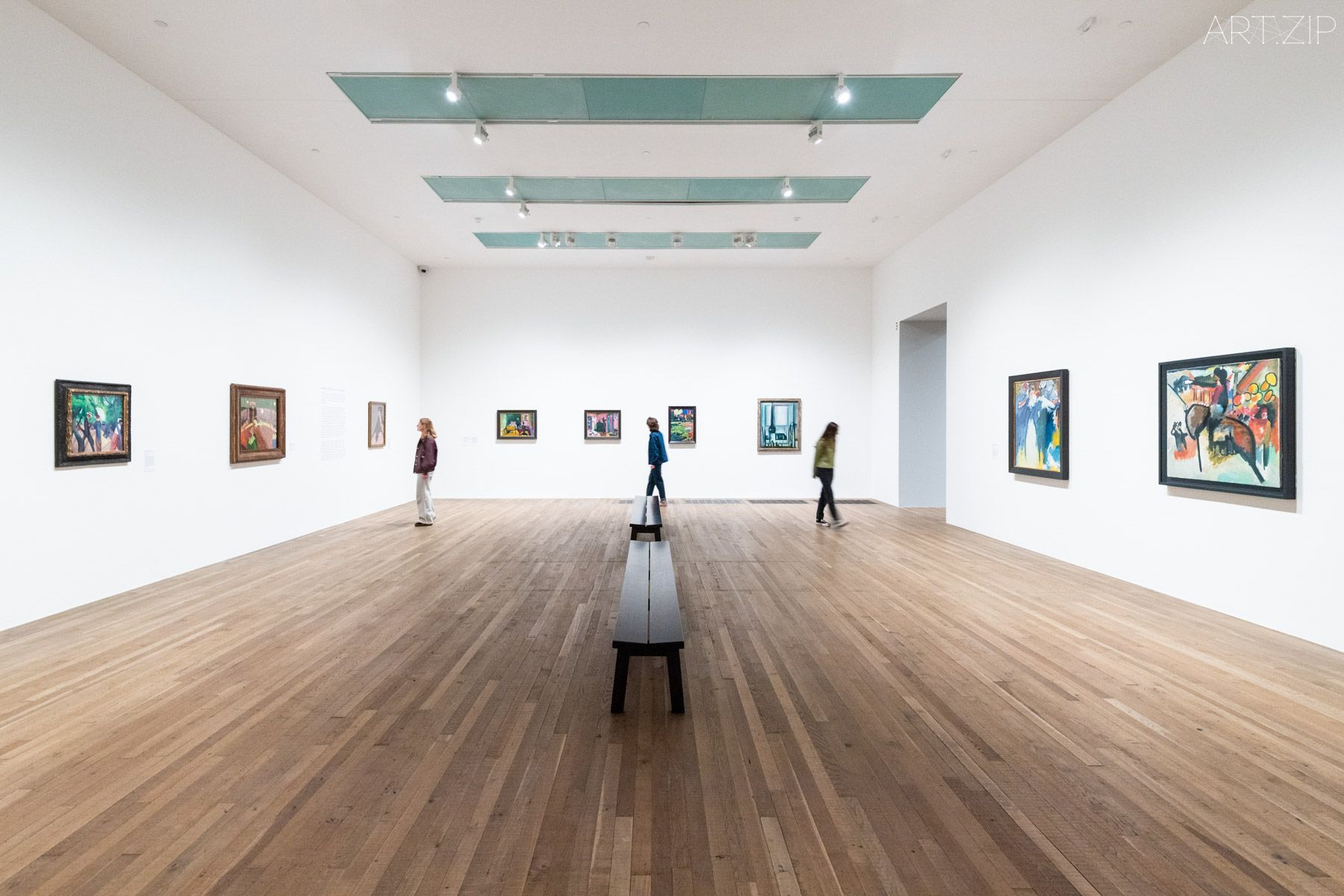
Expressionists: Kandinsky, Münter and the Blue Rider installation view at Tate Modern 2024. Photo © Tate (Larina Fernandes)
The Blue Rider Movement was formed in and around Munich, out a confluence of friendships and shared preoccupations. Something was in the air, an air that was thick with currents, moving first one way, and then another way, but always within a multiplicity of currents. Painting could then capture the intensities that joined together the new configurations of space and time as part of this charged reality. All the elements were touched by circulation of the ‘yet to come’ which was dwelling within the invisibility of the collective imagination. New thought forms were starting to become actualised within a new continent of feeling. Lines appeared to curve, so demarcations were redrawn according to this principle. In turn spaces softened and became mutable. The idea of the spiritual manifested in part as a tenderness. The paintings of Franz Marc expressed the tenderness within the animal realm, the passage from the third to the fourth dimension was likewise a passage of tenderness. Painting then recorded feelings passing through all dimensions and relationships, but it was abstraction that became the root into the radiance of the idea that opened out onto the mutuality of all things. Within the philosophical matrix this would be termed as aesthetic monism, the world as a single substance. History consists of deductions and categories which generate representational forms of abstraction, whereas arts route into abstraction is that of an arrival of what is other than representation, or as a presentation of a speculative becoming. History is the sum total of all the facts that might be accrued whereas art is an intuitive synthesis of all the possible sensations that might have been presented. Art is this sense certainly has a history, but it is not able to inhabit the same orders of abstraction because art is not a pure object of knowledge affirming its own facts of existence. Therefore it can be claimed that history constitutes itself as the grain that art rubs up against, becoming in turn an irritant. That is why art has been subjected to so much fire within its history.
藍騎士運動起源於慕尼黑及其周邊,由一群友誼深厚的藝術家和共同的藝術追求所驅動而成形。當時的空氣彷彿充滿了某種厚重的流動感,潮流先朝一個方向推進,隨即轉向另一方向,總是在多重動態中交織。繪畫捕捉了這股流動所帶來的新空間與時間的結構,成為這種充滿能量的現實的一部分。所有元素都被「尚未到來之物」的流動所觸及,這種流動隱藏於集體想像的無形之中。一種嶄新的感知形態逐漸顯現,情感也開始延伸至新的疆域,線條彎曲,邊界被重新繪製,空間因而變得柔軟且富有彈性。靈性在這一過程中顯現為一種溫柔的情感力量。
弗朗茲·馬克(Franz Marc)的畫作體現了動物世界中的溫情,從第三維度到第四維度的轉化,也是這種溫情的流動。繪畫記錄了情感穿越所有維度和關係的過程,而抽象則成為通往普遍聯結的核心途徑,展現了萬物相互交織的光輝。在哲學的語境中,這被稱為美學一元論,認為世界是一種單一的本質。歷史由歸納和分類構成,生成再現的抽象形式;而藝術通往抽象的路徑,則是非再現性之物的到來,或者說是未來推測性「成為」的展現。歷史是所有既知事實的總和,而藝術則是所有可能感知的直覺綜合。
因此,歷史對藝術而言如同砂礫,藝術正是在與歷史的摩擦中釋放其潛能,這種摩擦常成為一種刺激,也是一種挑戰。這也解釋了為何藝術在歷史中頻繁受到攻擊與考驗。
The relationship between history and art provides a rich tapestry of possible reflection. For instance, with the case of official portraits, state monuments, memorial sculptures, academic history painting, and other such inscriptive vestiges, the closer such entities are to being a marker of historical processes, the less aesthetic reflection appears to be in evidence. Equally the more that art displays autonomy, then the more the artefacts appear to be cut free from the grain or traction of time that we designate as historical. Modernist art has been particularly prone to themes such as fragmentation, haunting, ruination, abjection, alienation, abstraction, apocalypse, destruction as constellations that are formed as a counter point to any notion of history figured as a progression.
And so, we come to the room that is the culmination on this vision before the First World War was to bury it with the weight of exploded soil, ruins, and ashes. Cruel historical destiny: paintings far too delicate to arrest that. Who was it that evoked the image of soldiers taking copies of Holderlin’s poetry to read in the trenches? And so, sitting in that room with three Franz Marc paintings and four Kandinsky abstractions on the next wall, each in turn, making their promises to the yet to come. Harmonics, intensities, radiance, saturations, are all in circulation in these conjunctions. I wasn’t counting or marking my steps, but instead inclined to sitting down to collect the circulations absorbed into thought as it turns into a vapour. The room is full of this vapour, vapour in circulation, but also awaiting the silent weight of history to quell it. So much promised, so much lost. Northern Expressionism (The Bridge) provided a face (angst) for this shift in historical ‘coming to be’, whereas Southern Expressionism had no face with which to view it because of its desire to escape from gravity of representational schemas. History is the expectancy of death, whose face looks downwards. To be subjected to history is to look down and to feel its weight. It is true that art has an history, but it is a history that it is invariably attempting to resist or reshape. Sitting in that room is like feeling the weight of history in contrast to the light orientation of art as radically other. In turn we employ the metaphor of shadows and darkness in the aftermath of its relentless drive simply to exercise itself as force in order that the reiteration of history seeming to write itself as a mantra of truth.
歷史與藝術之間的關係編織出一幅豐富而多層次的反思織錦。例如,官方肖像、國家紀念碑、紀念雕塑、學院派歷史繪畫等帶有銘刻性質的遺跡,這些實體越接近歷史進程的象徵,其美學反思的可能性便越顯匱乏。反之,當藝術更強調自身的自主性時,作品似乎能更有效地擺脫我們所謂的歷史時間的紋理或牽制,從而獲得更多自由。現代主義藝術尤為偏向探討以下主題:碎裂、幽靈般的徘徊、廢墟、排斥、疏離、抽象、末世與毀滅等。這些主題猶如一組星座,形成了一種與將歷史視為進步線性的觀念相對立的表達方式,揭示出歷史進程中潛藏的斷裂與張力。
於是,我們來到了這間房間——這場視野的頂點,而第一次世界大戰即將以炸裂的泥土、廢墟與灰燼的重量將其埋葬。殘酷的歷史命運,脆弱的畫作無力阻擋這一切。是誰描繪了這樣的場景?士兵們攜帶荷爾德林的詩集,在戰壕中誦讀,試圖從詩句中汲取慰藉。
我坐在這間房裡,環繞的是三幅弗朗茲·馬克的畫作,而另一面牆上則掛著四幅康定斯基的抽象作品。每一幅作品似乎都向「尚未到來之物」做出自己的承諾。和諧、強度、光輝與飽和的色彩在這些作品的交織中流動。我沒有數著自己的步伐,也沒有刻意標記時間,而是選擇坐下,靜靜地讓這些流動的感知滲入思緒,化為蒸氣般的思考。整個房間充滿了這種蒸氣,無聲地循環著,但也似乎在等待歷史那沉重的壓力將其壓制。承諾那麼多,失落卻也那麼深。
北方表現主義(「橋派」)為這場歷史「成為」的轉變賦予了一張臉——一張飽含焦慮的面孔;而南方表現主義卻選擇了無面之觀,因為它試圖逃離再現體系的重力。歷史是一種對死亡的期待,它的面向始終朝下,散發出沉重的壓迫感。受制於歷史,就像是低下頭,感受其不容逃避的重量。藝術固然有自己的歷史,但這段歷史卻是藝術不斷試圖抗拒或重塑的對象。
坐在這間房裡,感覺就像在承受歷史的壓力,與藝術那種輕盈且完全不同的指向形成鮮明對比。我們常用「陰影」與「黑暗」的隱喻來描述歷史無情的推進,它似乎不過是為了展現自身作為一種力量的存在。而在這種力量的推動下,歷史一遍又一遍地將自身書寫成某種真理的咒語,反覆強調其不可置疑的權威性。
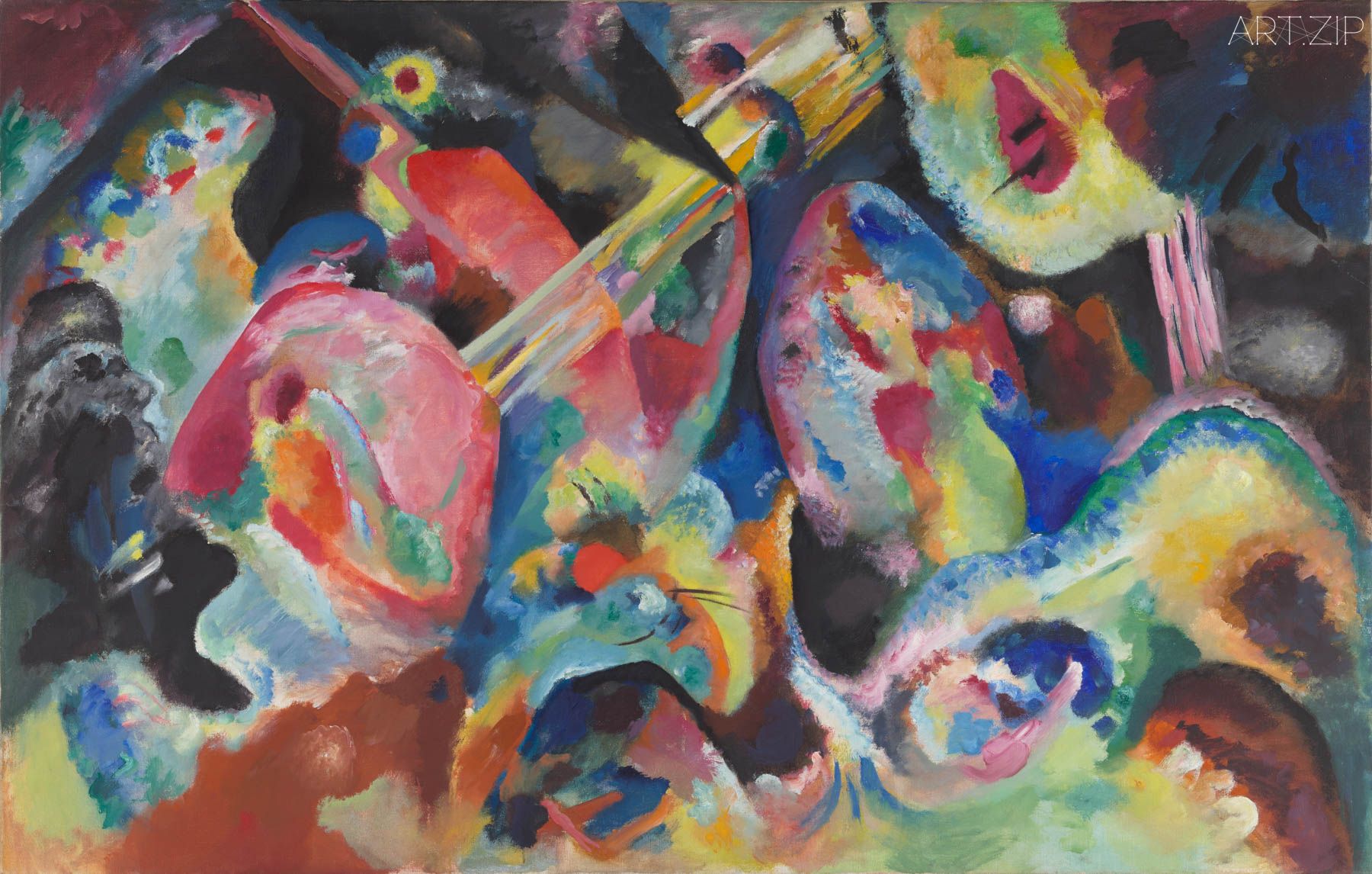
Wassily Kandinsky, Improvisation Deluge, 1913. Stadtische Galerie im Lenbachhaus
We appear to be constantly being given over the theories of conspiracies and mutterings of paranoias about the dark state and this is perhaps more accurately a reflection of the seeming autonomy that resides within historical gravity. The theorisation of conspiracies of this or that brings with it a vestige of hope within the idea of human agency, when in fact it is more likely the result of its progressive descent. History finds its twin companion in disaster, which when coupled are a mere hop skip away from extinction and that is why art in order to be art should offer nothing to the figure that we call history, for to do so would be to implicate itself to a mode of instrumental reason which would place it outside of the orbit of the excess of poetic a-signification. It is not that we are in lack of representation, but that we are the very exposure of too much by way of it. Politicians embody this fault line of reason and are made vain because of it. Art it can be said provides nothing which can offer an alternative to this situation, it is after all the yielding to a form of radical passivity in the face of this condition. Its posture is neither that of a lecture, nor as a prayer, but is closer to sitting in a room whose offering might make us prone to wonder.
The term Abstract Expressionism was appropriated as a term for the New York School of painting in the post Second World War period. It was employed to emblemize aesthetic freedom, as opposed to the art of Social Realism which was said to stand for the repression of its other. The ‘Improvisations’ and ‘Compositions’ of Kandinsky opened out a sense within New York painting that was expressive of a purification of painterly gesture that excluded narrative traces. Yet this did not exclude references to beat and hip culture with its rhetoric of outsider poetics and it was this that added ambiguity to its status as assuming the mantle of the Modernist ideal. It was an appropriation of European aesthetic anxiety tuned to American energetics that drew upon cinematic like epic scale that in turn defined the look of this aesthetic. In contrast the Blue Rider Movement appeared domestic and intimate, almost delicate in its manner. The residue of spirituality within Abstract Expressionism in New York also stood in contrast with an aggressive way of finding a place within the urbanism of everyday life. Both movements were finally bathed partly in tragedy but their system of rhetorical address profoundly different, one touched by a reality of a war to come and one with a war expended, but one that continued in a new form for which it was indirectly co-opted into. No measure relating to such a relationship can be calculated but it remains a trace relationship or vestige of the otherness contained with a schema of art history bereft of the capacity to find adequate language for its passage into darkened poetics. The collection of Kandinsky painting in the Guggenheim Museum in New York stands as a testimony for a fascination with an early Modernity that desired another light or destination but was forced to negotiate the fractured space of aesthetic encounter in which abstraction was to pass into style or manner. Kandinsky stayed true to the memory of utopian poetics whilst living on with the reality of its loss of within imaginative reflection.
I was sitting in a room surrounded by paintings which ushered in this sequence of reflection. This is not a usual occurrence. A friend asked me if it might have induced tears, but I declined a direct answer, and instead stated that if it was the case, then the tears would be double, first as a subject facing itself, but the second time, as a subject losing the possibility of this. Maybe I sat for ten minutes, or even less than this. Who knows or cares? I was touched by the sense of being bereft of properly knowing what I thought or how I thought. One tear for that condition, and another tear for having felt that incapacity was a possibility.
我們似乎總是被各種陰謀論以及對黑暗政權的偏執低語所籠罩,而這或許更準確地反映了歷史重力中那種表面上看似自主的特質。對陰謀的理論化,儘管帶來了一絲關於人類行動力的希望幻影,但實際上,它更可能是歷史逐步墮落的結果。歷史與災難如同一對孿生伴侶,當這兩者結合時,距離滅絕僅有一步之遙。正因如此,藝術若要成為真正的藝術,就不應向我們所謂的「歷史」提供任何東西。這樣做,無異於將自身捲入一種工具理性的模式,而這種模式會將藝術推離詩意的過剩與非指涉性(a-signification)的軌道。問題並不在於我們缺乏再現,而在於我們過度暴露於再現之中。政治家恰好體現了這種理性的裂縫,而也正因此,他們陷入虛榮與空洞之中。
藝術無法提供替代這種處境的答案。從根本上說,藝術是在面對這種狀況時選擇了一種徹底的消極順應。藝術的姿態既非訓誡,也非祈禱,而更像是靜坐在一間房間裡,提供一種可能讓我們重新驚歎與深思的契機。
「抽象表現主義」一詞在二戰後被用來指代紐約畫派的繪畫風格,象徵著一種美學上的自由。它與社會現實主義形成鮮明對立,後者常被視為壓抑性他者的代名詞。康定斯基的《即興》和《構圖》系列為紐約繪畫帶來了一種全新的感知視角,通過純化繪畫的手勢,剔除敘事的痕跡。然而,這並未完全排除它與「垮掉派」文化及「hip」文化的聯繫。這些邊緣化文化中的詩意修辭,為抽象表現主義的現代主義理想增添了一層模糊性。這一風格既是對歐洲美學焦慮的挪用,又被調和為美國活力的展現,以電影般的史詩尺度為基調,進而定義了這一美學的外觀。
相比之下,藍騎士運動顯得更加內向和親密,其風格近乎精緻且柔和。紐約抽象表現主義中殘存的靈性氣息,與其在日常城市生活中激進且衝突的表現方式形成了鮮明對比。最終,這兩場運動都帶有某種悲劇性的烙印,但其修辭語言截然不同。一個受即將來臨的戰爭現實所觸動,另一個則承載了一場已結束戰爭的殘餘,並隨之被吸納為一種新形式。這種微妙的關係難以量化,但它作為一種痕跡或遺存依然存在,體現了藝術史架構中那種難以言喻的他者性,而這種他者性又缺乏足夠的語言來表述它向黑暗詩學邊界的推進。
紐約古根海姆博物館中收藏的康定斯基畫作,見證了早期現代主義對另一種光芒或目的地的迷戀。然而,這種追求不可避免地要在美學邂逅的破碎空間中尋求妥協,最終使抽象轉化為一種風格或形式化的表達。在這一過程中,康定斯基始終忠於烏托邦詩學的記憶,儘管他不得不在現實中直面這種烏托邦的失落,但他依然在想像性的反思中持續探索其遺留的意義。
我坐在一間房間裡,四周環繞著畫作,這些畫作引發了一連串的深刻沉思。這並不是一種尋常的經歷。一位朋友問我,這是否讓我落淚,我沒有直接回答,而是說,如果真有淚水滑落,那麼這淚水應該是雙重的:第一次,是作為一個主體直面自身;第二次,則是作為一個主體意識到自己失去了直面自身的可能性。或許我只坐了十分鐘,甚至更短。誰會知道呢?又有誰會在意?我深深被一種無以名狀的感覺所觸動——一種無法確切知道自己在想什麼或如何思考的無助感。一滴眼淚,為這種迷茫的處境而流;另一滴,為察覺到這種無力竟然也能成為一種可能性而流。
In a sea of information, we might be moved by that which is able to dwell with this idea that there can be a bearer of non-knowledge capable of transforming relation. Both art and history appear to be adrift not only from each other but from their own sense of being completed figures. It is no longer just enough to mark this passage with the prefix of ‘post’.
Post-ness is still a dialectical figure of thought, even if it accepts the possibility of suspension or spacing rupturing continuity. Neither is this a sublime figure because contained within this would be a moral reflect capable of restoration. What is before and what is beyond no longer fits neatly into place, but they are within the circulations that are our lived complications. Sitting in the room, something is afforded by that, but I cannot name this, but does this imply a blank-ness that requires a desire for movement through this?
Perhaps I should concentrate on sitting better because with this attention might form itself with greater clarity.
在信息的海洋中,我們或許會被某些東西觸動——那些能與這樣一種觀念共存的東西:有一種非知識的承載者,可以改變人與人、事物與事物之間的關係。藝術與歷史似乎不僅彼此漂浮、分離,甚至與它們作為完整形象的概念也脫節了。僅僅用「後」(post)這個前綴來標記這一過程,已經遠遠不夠。
「後」的概念依然是辯證性思維的產物,儘管它接受了中止或空間化可能帶來的連續性破裂。它也並非一種崇高的形態,因為如果是崇高,則其本質應包含一種能夠帶來修復的道德反思。然而,何為「之前」與「之後」已經無法再被清晰地界定。它們不再是固定的時間段,而是交織在我們生活中那些複雜的流動之中。
坐在這間房間裡,我能感受到某種無形的賦予,但卻無法為其命名。這是否暗示著某種空白?並且這空白是否需要我們懷抱一種渴望,穿越其中,尋找意義?
也許,我應該更專注於「如何坐下」,因為唯有如此,注意力才能更為清晰地成形,或許真理也能在這片片刻的凝神中顯現。
Expressionists: Kandinsky, Münter and the Blue Rider
25 April – 20 October 2024
Tate Modern, London
Text by Jonathan Miles

